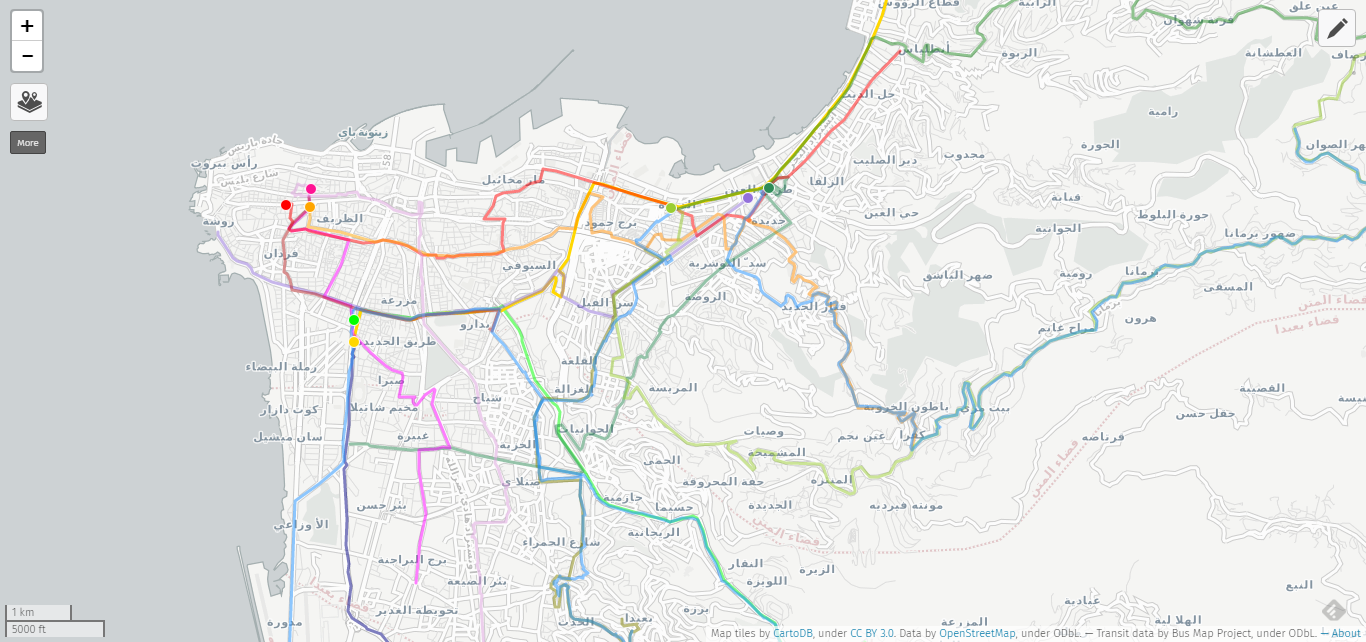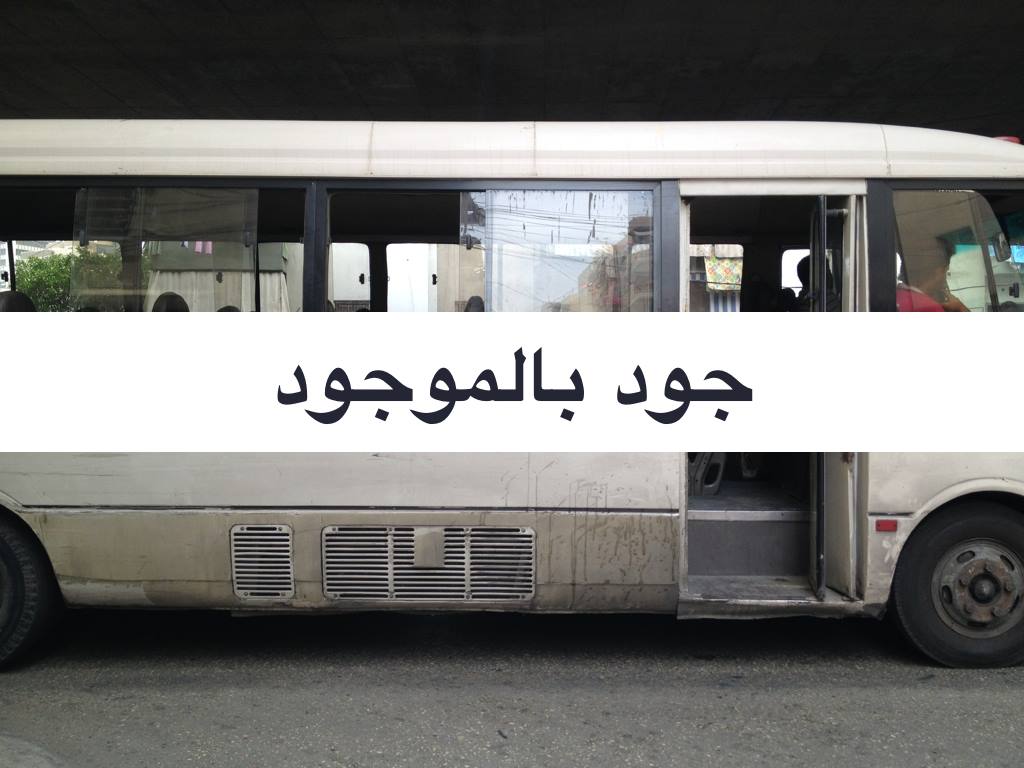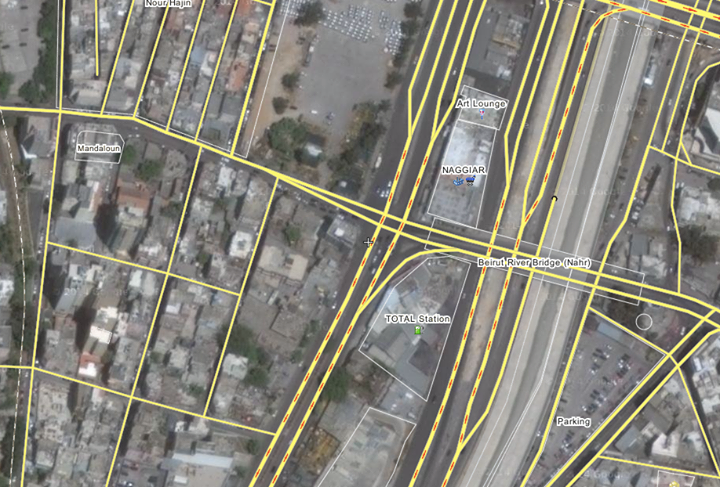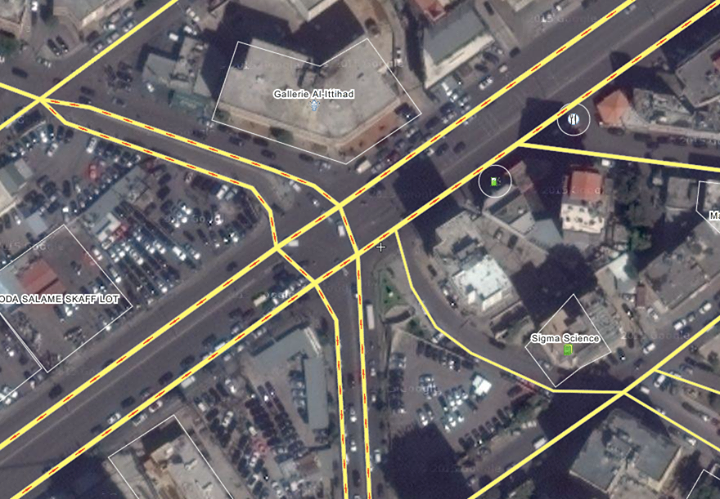
Good morning, Beirut! It’s still pretty messy, but it’s getting there!

Good morning, Beirut! It’s still pretty messy, but it’s getting there!
Here’s a sneak preview of our first, ten, mapped bus routes!
We tracked these using LiveTrekker and Gaia GPS, and dumped them raw onto Google Maps. The routes will need to be cleaned up and labelled (and there’s a lot more coming!) but it’s fun to see the system start to take (some) shape and make (more) sense.

Live outside of Beirut? Want to help us track more bus routes? Yalla!
We’re excited to share this documentary by our friend Nora Niasari, now available to view online! Production of this short film on Beirut’s public transport began in 2010. In 2011, “Beirut, Under the Bridge” was awarded ‘Best Director Documentary’ and ‘Special Jury Prize Documentary’ at the 11th Beirut International Film Festival, and was broadcast on CNN and MTV Lebanon.
We asked Nora to reflect on her project, nearly six years on: “For me, Beirut is a city of unspoken potential. In 2010, our film stirred up a mostly dormant debate about public transport, asking why the sector was effectively buried alive after the civil war. We learned many things, but today, transport workers and transport users alike are still asking, “Where are we headed?”
Read more about Nora’s experience here.
This week, we took part in #CitizenDesigner, a three-day event hosted by Graphicism at the Lebanese University in Hadath. Here’s a quick summary of what we presented:
It’s important to emphasize that we’re not proposing anything radically new. We draw inspiration from nearby experiences like the Nairobi Digital Matatus initiative, and the World Bank’s mapping project in Egypt. We can learn from these examples, and adapt them to our own context.
While the idea and technology might not be new, our approach to public transport advocacy in Beirut is a little bit different. Bus Map Project aims to be collaborative, open source, gradual and modular. All these buzzwords simply mean that we are a platform for your input and concerns. They also mean that we believe in treating the existing bus system the same way. Ya3ne, for us, “Citizen Design” means taking existing systems seriously.

Thank you Green Line for inviting us to discuss our tiny project at yesterday’s “Local Governance of the Transport Sector: Roles & Responsibilities” event. It was great having such a wide range of actors and stakeholders in the same room, and we hope to see this pluralism strengthened and expanded in the future.
As was clear from the rich debates we heard throughout the day, different perspectives will not always see eye to eye. What we think about transportation is determined by what we believe about government, economy, society, etc. We all know that. But even if we agree on the broad slogans, the difficult questions of strategy, method and approach will remain.
As Bus Map Project, we spoke from the perspective of bus riders. While we do not claim to represent anyone other than ourselves, our thinking — as summarized in this slide — is founded on a simple belief: public transport can improve when the riding public begins to speak as riders. This can happen in so many ways: when ridership expands, or when the sector enters the public eye like electricity or waste management has done, or through the relationships we form in the process of collective mapping, etc. But at its most basic level, this begins in the simple act of insisting that *we exist* . . .
That is the core message of our project. The map is a tool we put to use.
This is the OCFTC Number 5, from Nahr El Mott to Bhaness.
Don’t confuse it with the other Number 5, that goes from Hamra to Ain Saadeh.
Both 5s go to Ain Saadeh via Fanar, but each takes a different route through town: the OCFCT Number 5 via the Lebanese University (Fanar Campus) road, and the private Number 5 via ‘7ay al-Arman‘.
On August 22, a campaign based around the ongoing waste (mis)management crisis in Lebanon became much much more. The movement called طلعت ريحتكم struck a chord with people across Lebanon, and brought thousands into Riad al-Solh Square to voice their anger over a wide range of policy failures and socioeconomic issues. At the center of this discontent is the generalized syndrome of deadlock in governance in the country, but others have gone further in their diagnoses. Many have focused on the endemic culture of nepotism and corruption among the semi-feudal political class ruling the country. Others have struck at the root, focusing on the confessional system itself as the perpetual engine of division, unaccountability and immobilism. Others have dug even deeper into the capitalist system as the context of contexts for our problems.
In the days that followed that fateful Saturday, several factors have pushed and pulled the movement in different directions. First, there was the inexplicable and inexcusable state violence against protesters, which fueled anger and encouraged more people to join. Second, there were the fears of party-orchestrated infiltration and sabotage, and the resulting controversy among movement supporters over the classist and sectarian overtones of these fears, and the ways that protest organizers chose to respond to them. Finally, there was the plurality of proposals and counterproposals for the way forward with movement demands, stemming from the various criss-crossing analyses described above. By August 29, the movement grew far beyond its initial scope and framing as #YouStink, and became a true platform for mass political action.
Today, a host of inspiring groups, new and established, are active “in the square” — community-based campaigns like عكار_مش_مزبلة, citizen journalism projects like أخبار الساحة, recycling initiatives like Sar Lezem Rassak Yifroz, anti-capitalist fora like المنشور, student organizations like AUB Secular Club, and advocacy networks like National Campaign for Sustainable Transportation, etc.
This means that the visions, missions and approaches are now many. Where do we go from here?
Bus Map Project was conceived as a modest, small-scale intervention in the gaps between state neglect and policy-oriented advocacy. We chose a pragmatic approach that strategically set aside the twin issues of rights and demands. We stubbornly focused on the present — on the bus system as it exists today, without quick judgement or dismissal — because we felt that other pro-transit campaigns have either focused too much on the past (e.g. the state’s neglect of public transport) or too much on the future (e.g. a desired public transport system). More fundamentally, we chose an approach that would bypass the state altogether — with or without a president, with or without a parliament, with or without a responsive Ministry of Public Works & Transport, we want to begin collectively building our own tools that help us make sense of and navigate our cities.
We support the current climate of protest. We believe that more awareness of the systemic problems that produce so many failures across so many sectors — from housing to transport to the environment — is important. Our project has only just started, but we wish to contribute to this ongoing conversation sparked by #YouStink by calling for more small-scale, closely-allied, locally-based, and non-state reliant projects focused on the tail-end of the crises created by Lebanon’s broken system of governance. The movement’s broader slogans — anti-corruption, secularism, electoral reform, parliamentary renewal — are of vital importance, but we believe that Lebanon also needs solutions in the here-and-now. We need better representation, better institutions, etc, but we also need less dependence, less centralization, less delegation of our power to connect and work together as civic actors.
This is not a call to “de-politicize” the movement — that is impossible. It is, however, a plea for more fidelity to the immediate, to the concrete, and to ourselves. There is strength in numbers — a single-issue campaign acting alone will struggle to accomplish anything, but a sustained and focused project acting within a broad network of supportive campaigns is more likely to succeed, for the benefit of all. Yalla.
If you are interested in learning more about how you can help Bus Map Project, please do not hesitate to contact us.
“My bus ride to work each day thus provides a glimpse into the simmering sectarian divisions of the city.”
We often see our city’s fragments and divisions, but what about the networks and connections that stitch them together?
This bus ride is also a glimpse into what endures despite division.
‘These are the stories of citizens who head to Beirut and its environs for work, every day, from the four corners of the nation, and who return to their home towns and villages in the evening to ‘divide the bread’ of their workday with their families.’
Have a look at this very important article (in Arabic) that first ran in As-Safir Newspaper. The issue of public transport cannot be disconnected from the prohibitive price of rent and housing in Beirut, the over-concentration of jobs in urban centers, and other wider issues of demography.
Areas served by few or infrequent buses — called ‘transit deserts’ — reflect these socioeconomic patterns, and can often make them worse by skewing our choices of where to live and work. The lack of night services on many routes also affects people’s choices of where to go and who to interact with.
Mapping can help us figure out which regions are under-served by public transport, and in doing so, point to underlying inequalities that can be improved — but not solved — by better network coverage.
How are your day-to-day choices of where to live, who to meet, etc., affected by the transport system? Let us know on our Facebook page.
One of the trickiest aspects of bus travel in Lebanon is figuring out the best and most efficient spots to transfer between different bus routes with little or no walking.

For example, the corner of Armenia Street and Cornich El Naher is a good place to hop off the Number 5 and catch the Number 6 or Number 15 to Cola Roundabout. For the return trip, getting off the Number 15 on Boulevard Sin el-Fil, near Gallery Al-Ittihad, is the best way to catch the Number 2, or get back on the Number 5.

What are your favorite tips and tricks for multi-stage bus travel?